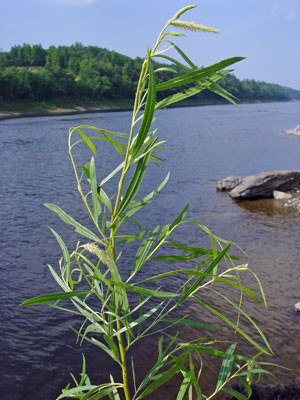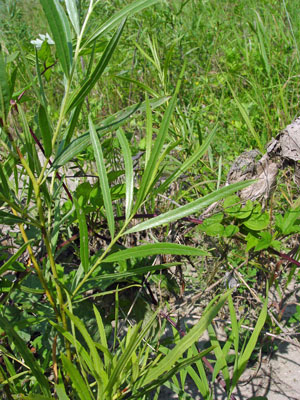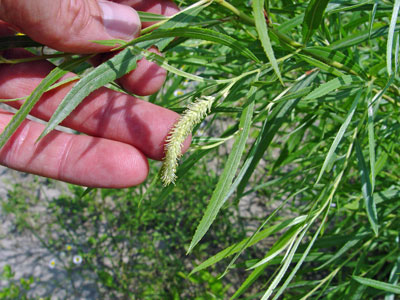DACF Home → Bureaus & Programs → Maine Natural Areas Program → Communities, Plants, and Animals → Rare Plants → Salix exigua ssp. interior

Salix exigua Nutt. ssp. interior (Rowlee) Cronq.
Sandbar Willow
- State Rank: S1
- Global Rank: G5
- State Status: Endangered
Habitat: Sandbars, mudbars, and moist alluvial soil. [Non-tidal rivershore (non-forested, seasonally wet)]
Range: Quebec to Athabasca, Virginia, Kentucky and Texas.
Aids to Identification: Willows are recognized by their winter buds and flowers. Their buds are covered by a single cap-like scale. Their flowers are very small and are borne in catkins. Indentification of willows is complicated by the fact that these plants are dioecious - the staminate and carpellate flowers are borne on separate plants. The sandbar willow is a shrub, growing usually 1-1.5 m high, with elongate, sharply pointed leaves with teeth at the edges spaced far apart. The leaves are borne on short petioles less than 3 mm long and are green on both surfaces. Carpellate flowers have a large sessile stigma. The filaments of stamens are densely pubescent in the basal half.

Ecological characteristics: Found along river banks, often one of the earliest species to colonize these areas.
Phenology: Flowers April - May.
Family: Salicaceae
Synonyms: Salix exigua Nutt. var. exterior (Fern.) C.F. Reed; Salix exigua Nutt. var. pedicellata (Anderss.) Cronq.; Salix exigua Nutt. var. sericans (Nees) Nesom; Salix fluviatilis Nutt. var. sericans (Nees) Boivin; Salix interior Rowlee; Salix interior Rowlee var. exterior Fern.; Salix interior Rowlee var. pedicellata (Anderss.) C.R. Ball; Salix interior Rowlee var. wheeleri Rowlee; Salix longifolia Muhl.; Salix longifolia Muhl. var interior (Rowlee) M.E. Jones; Salix longifolia Muhl. var sericans Nees; Salix longifolia Muhl. var wheeleri (Rowlee) C.K. Schneider; Salix wheeleri (Rowlee) Rydb.
Known Distribution in Maine: This rare plant has been documented from a total of 4 town(s) in the following county(ies): Aroostook, Kennebec, Oxford.

Reason(s) for rarity: Scarcity of open rivershore habitat.
Conservation considerations: Maintain hydrologic integrity of its rivershore habitat, including the natural disturbance.